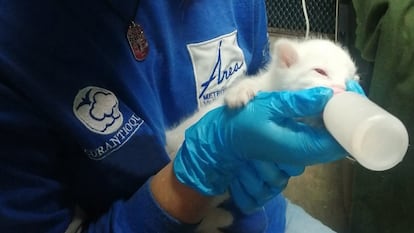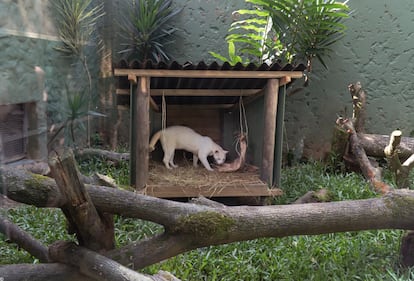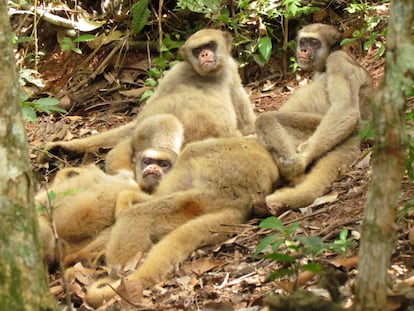The world’s first known albino ocelot worries scientists
Experts warn that the specimen, a white female raised in the Medellin Conservation Park, is a byproduct of deforestation: ‘There is no need to be happy that it exists’
The world’s only known albino ocelot is blind – but you can’t tell by looking at her. The animal displays her agility with ease when facing a straw-filled paper package that hangs from a rope, taunting her. The videos show how she rises and strikes repeatedly to destroy it: there is a piece of meat inside, an incentive to exercise her hunting instincts. She lives in the Medellin Conservation Park, in a shelter with no tall structures that can put her at risk, and under controlled lighting. She would be an easy prey in the forest, where she cannot camouflage herself to hunt the birds or reptiles she needs to survive. That is what brought her to the park a year ago, almost dead due to her unusual white color, the consequence of a disease that, according to experts, is an indication of the deterioration of the native forests of Antioquia.
Her keepers now know that she is an ocelot, one of Colombia’s wild cats, like the jaguar, the puma, the margay and the jaguarundi. But identifying her was difficult, because usually body dimensions and fur colors are used to that end. When she was found, her small size suggested that she was a cat; when she grew larger, they suspected her to be a jaguarundi. Finally, after a series of studies in the laboratories of the University of Antioquia and the National Police she was identified as a leopardus pardalis or ocelot. Thus, a few weeks ago, she went from being “the albino feline” to being “the albino ocelot,” says Jorge Londoño, a spokesman for the park.
She currently weighs close to 28 pounds, when on December 23, 2021, she arrived weighing less than one. She eats incessantly, so much so that her keepers had to reduce her diet from 2 to 1.5 pounds of meat a day. She loves meat, especially chicken blood sausage, and has a weakness for the smell of lavender that her ethologist, Elisa Madrigal, uses to stimulate her. The park keeps her name a secret to prevent visitors from calling her and confusing her.

The feline showed up in November 2021 in Cañón del Mata, a wooded area in Amalfi (northeast of Antioquia). A child took care of her for a few days, until the mayor’s office notified the Regional Autonomous Corporation of Central Antioquia (Corantioquia). The organization, in charge of protecting biodiversity, rescued her from an almost certain death: she was malnourished and had digestive and respiratory problems. Her white color and the visible irrigation of blood in her irises, which makes her eyes red, were evidence of the absence of melamine. That is, albinism.
Scientists believe that the mother abandoned her white cub in order to protect the healthy siblings, which were exposed in the den when the mother went hunting. The white color could have made them easy prey for an owl, a hawk or an eagle. Furthermore, the blindness made nursing difficult. Maternal instinct may have prioritized protecting the healthy kittens.
Mixed feelings
Biologist Catalina Díaz Vasco says in a phone interview that the finding generated mixed feelings in her. “Scientific curiosity” makes her happy to be able work with a unique specimen: she knows that research on this ocelot will help those who are interested in studying rare genetic mutations in felines. She also feels an emotional bond. “We take great care of her,” she remarks. However, she knows that the animal has suffered and that her presence does not speak well about the state of the forests in Antioquia. “Several publications will have a celebratory tone, but there is no need to be happy that it exists,” she emphasizes.
The albino ocelot is proof of high levels of consanguinity in the population in which it inhabits, and this generates concern that the species may disappear locally, despite not being classified globally as severely endangered. Díaz explains that albinism is a recessive mutation which is only activated when both parents carry the gene; it is not usual for two carriers to match, unless they live within small populations.

Ana Cristina Fernández, a biologist from Corantioquia, points out that the previous existence of other albino ocelots is possible, too. “The gene that produces albinism has been circulating for who knows how long,” she says. Other specimens probably died before being found, which is likely because they can only live a few weeks in a hostile environment.
The felines are in a vulnerable situation because human activity has increased in the area where they live. According to a report by the Antioquia Forest Observatory, approximately 490,000 hectares of forest were lost in Antioquia between 2000 and 2019. Cattle ranching, mining and coffee plantations interrupt the natural corridors that connect the forests, and this affects the ocelots’ ability to reproduce with more genetically diverse specimens. Díaz says that fragmentation is a serious problem, despite the fact that the municipality of Amalfi still has forests of good quality. “It is more important to have small, well-connected patches of forest than a larger but isolated area,” she explains.
The plan to reverse this situation involves reforesting some areas and signing agreements with farm owners who pledge to preserve existing strips of vegetation. For Díaz, it is important that the ocelots do not disappear because they are essential to maintain the forests, which in turn provide essential services for human activity. The scientist describes them as parts of a machinery: “The ecosystem where these animals live provides clean water and protects against soil erosion. But in order for it to give us all that, it has to be healthy, and it needs all its parts. If the ocelots are not there, the herbivores that they eat will overexploit the forest.”
For now, the albino ocelot is safe and a source of pride for the Conservation Park. “She is spoiled because she is a symbol of rescue and shelter, recovery and resilience,” says spokesman Jorge Londoño. And it is true: the agility with which it moves contrasts with the sick little animal that was found in Amalfi. She is very well cared for, with a doctor on hand 24 hours a day and a nutritionist. In addition, she does not waste energy hunting or raising cubs. This is why ocelots in captivity can live up to 21 years, compared to 7 or 9 for those who remain in the wild.
But the case leaves several unanswered questions. The gene mutation usually comes with other serious ones such as heart deformities or kidney problems. So far they have not manifested in her, but there are no certainties about her life expectancy.
Sign up for our weekly newsletter to get more English-language news coverage from EL PAÍS USA Edition
Tu suscripción se está usando en otro dispositivo
¿Quieres añadir otro usuario a tu suscripción?
Si continúas leyendo en este dispositivo, no se podrá leer en el otro.
FlechaTu suscripción se está usando en otro dispositivo y solo puedes acceder a EL PAÍS desde un dispositivo a la vez.
Si quieres compartir tu cuenta, cambia tu suscripción a la modalidad Premium, así podrás añadir otro usuario. Cada uno accederá con su propia cuenta de email, lo que os permitirá personalizar vuestra experiencia en EL PAÍS.
¿Tienes una suscripción de empresa? Accede aquí para contratar más cuentas.
En el caso de no saber quién está usando tu cuenta, te recomendamos cambiar tu contraseña aquí.
Si decides continuar compartiendo tu cuenta, este mensaje se mostrará en tu dispositivo y en el de la otra persona que está usando tu cuenta de forma indefinida, afectando a tu experiencia de lectura. Puedes consultar aquí los términos y condiciones de la suscripción digital.












































